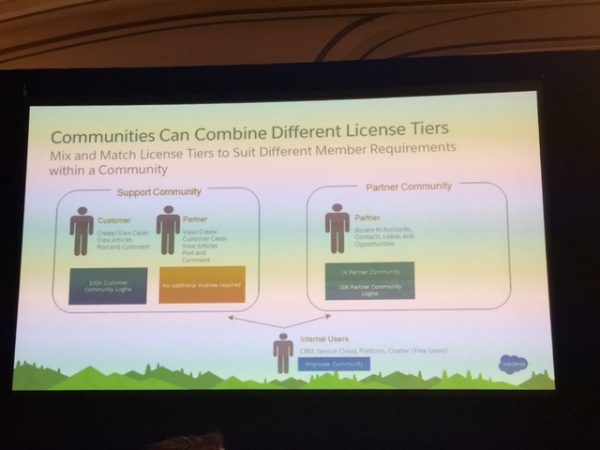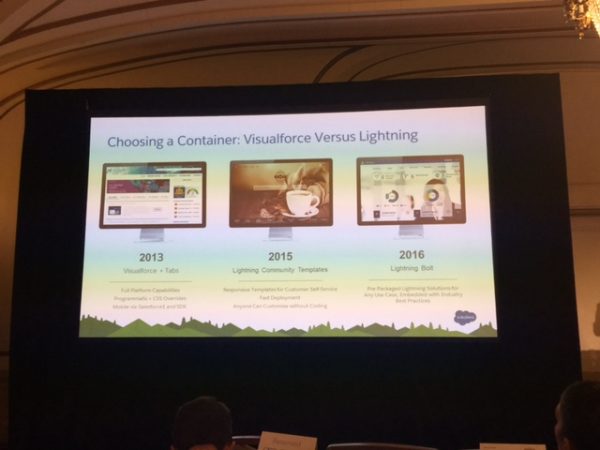What’s the next opportunity for you to engage with your customers, partners and suppliers, or employees? Salesforce Community Cloud is the answer. As organizations move away from the one-way, portal-centric conversations with an audience towards a more socially engaging model, communities are the perfect way for you to connect with an audience in an entirely new way. And with the introduction of Lightning Communities and announcement of Lightning Bolt at Dreamforce, we’ve met with a lot of Salesforce customers here already that are looking for where to start with the product. This session session was the perfect way to get your feet wet with exploring Community Cloud, so here’s a brief overview.
Community Cloud Licensing
The first place to start when it comes to making the decision to set up and deploy a community is to understand Salesforce’s licensing structure. Fabrice Talbot, Community Cloud Product Management Director at Salesforce, and Kara Allen, Community Cloud Practice Lead at Perficient, first covered the different types of licenses for external communities.
- Customer Community – B2C Communities with high-volume of users
- Customer Community Plus – B2B or B2C Communities for non-sales scenarios
- Partner Community – B2B Communities with access to CRM data and PRM features
Kara’s tip: Make sure you pick the right licenses at the get go by not only looking at your use cases, but also where you want to go with your community down the road to avoid having orphaned data or added data migration with your Community Cloud implementation.
Fabrice’s tip: You can mix and match different license tiers to suit different member requirements within a community. For a Customer Support Community you will have both Customer and Partner licenses with different functionality for each. In a Partner Community, you need to give partners access to Accounts, Contacts, Leads, and Opportunities. For a Social Intranet type community there is no added licensing for Salesforce users to access CRM, Service Cloud, Chatter, etc.

Users, Roles and Sharing
To create users you need to first create the Account, then a Contact which then becomes a User record, and finally a Community Member. Fabrice also covered global sharing and sharing sets for customer community users. Setting up role heirarchy is also a very important step in the setup process.
Kara’s tips: Avoid overcomplicating the roles and start simple! You also don’t want to do the sharing at the User level but rather the Role level when setting up a community.
Choosing a Container
With the announcement of Lightning Bolt at Dreamforce 2016, Community Cloud customers will have some pretty cool new toys to play with in the near future, so this is where the real fun begins! When developing requirements for building a community, this is also one of the most important steps because it can have a significant impact on the long-term vision for your community as you grow and look to turn on new areas or add new functionality.
Fabrice’s tip: Salesforce is doing all their investment on Lightning Communities Templates. Kara echoed Fabrice’s advice and commented about recommending this to almost 95% of our clients, except for some rare circumstances where custom development may be needed.

Kara also shared 3 great use cases for Community Cloud, summarized below:
Self-Service Support
Ancestry launched a Self-Service Support Community in late Spring 2016 to help them scale support as the business grew. They were also looking for ways to be able to expose knowledge and deliver support in multiple languages. Built using Lightning Community and Lightning Components, their community has been a huge success and is being featured today in a session at Dreamforce.
Case Deflection
NextGen Healthcare was very focused on improving case deflection and chose to build a Customer Community to help deflect cases and increase customer satisfaction. They chose to use Visualforce to handle a custom case deflection process and also integrate Knowledge and Known Issues as part of their community to give members access to other valuable information as they submit cases or search for answers in their knowledge base. Since going live, the NextGen service organization has experienced the following business outcomes:
- improved case deflection by 10% with Community Cloud
- reduced the average number of days to resolve a case by 50%
- cases resolved in less than 24 hours increased from 40% to 52%
- improved customer satisfaction scores by 31%
Partner Engagement
PureStorage wanted to have a mobile responsive community with CMS functionality. Perficient helped them migrate from Visualforce over to Templates with a new partner community designed to help them manage channel leads and opportunities in Salesforce. Their community is going live this week and excited to help them take advantage of all the new benefits of using Lightning Community Templates.
As you can see, there’s a few key steps but building a Lightning Community is pretty straightforward. For more information and a deeper dive into building an engaging community, download our guide on building an engaging community using Salesforce.
